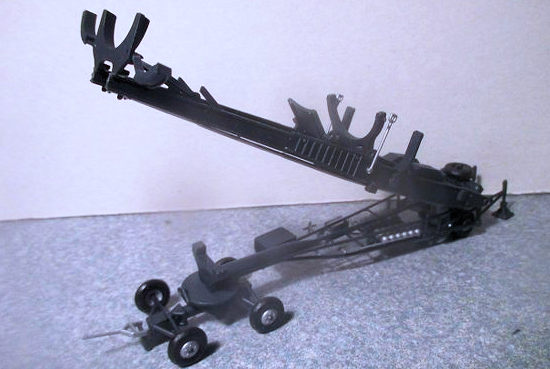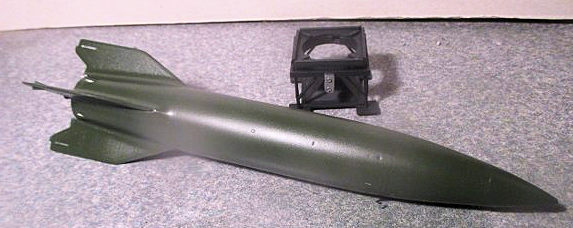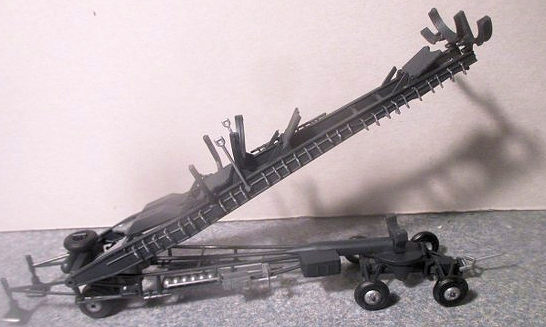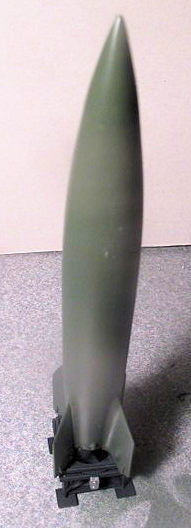
| KIT #: | H-1830 |
| PRICE: | $1.29 in 1969 |
| DECALS: | None supplied |
| REVIEWER: | Brian Baker |
| NOTES: | A very early kit of box scale missiles/rockets |

| HISTORY |
The German V-2 Rocket, also known as the A-4, was a 46 ft. long unguided liquid fuelled missile designed to attack targets in England from bases on the Continent. Developed using the basic research of Dr. Robert Goddard, the American researcher, the V-2 was the product of Dr. Werhner von Braun and a team of rocket engineers, who began development as early as 1930. By 1942, prototypes were ready for testing, and this extremely complex weapons system was originally launched from the Peenemunde test site. The rocket was powered by a liquid fuelled rocket motor, and weighed 28,000 pounds, including a 2000 pound Amatol warhead. During its burn time of sixty seconds, the rocket generated 25 tons of thrust, and a speed of 3800 mph.
 After extensive testing at
Pennemunde, the rockets were brought to the French coast, and deployed by
specialized units for action against London. Many of the rockets were wildly
inaccurate, and some exploded on the launch site. Most fell short of their
intended targets, but once launched, they were impossible to intercept or shoot
down. They did an enormous amount of damage, and must have created a
psychological nightmare among the British population, as they came with no
warning. They were certainly the ancestors of the ballistic missiles used today.
Postwar, many captured examples were brought to the United States, along with
Von Braun and other German scientists, and these formed the basis for the
American space program. Many were fired from White Sands, New Mexico, in the
forties and fifties.
After extensive testing at
Pennemunde, the rockets were brought to the French coast, and deployed by
specialized units for action against London. Many of the rockets were wildly
inaccurate, and some exploded on the launch site. Most fell short of their
intended targets, but once launched, they were impossible to intercept or shoot
down. They did an enormous amount of damage, and must have created a
psychological nightmare among the British population, as they came with no
warning. They were certainly the ancestors of the ballistic missiles used today.
Postwar, many captured examples were brought to the United States, along with
Von Braun and other German scientists, and these formed the basis for the
American space program. Many were fired from White Sands, New Mexico, in the
forties and fifties.
The instructions are printed on newsprint, and consist of 23 line drawings showing the assembly process. There is no sprue diagram, and most of the drawings are pretty clear. Basically, the parts are identified and numbered, and there is some painting information, since the kit is molded in dark grey, silver, and bright green plastic. Since the paper was 60 years old, I needed to use half a roll of scotch tape to hold the instruction sheets together.
| THE KIT |
 The kit consists of nearly
100 parts of various sizes, most of which are parts of the launching equipment.
The missile itself consists of 29 parts, and although the instructions say that
if you wish to display the missileís interior, do not cement the two fuselage
halves together. There is considerable detail in the rocket interior, and once
the halves are glued, nothing can be seen. I couldnít live with an open rocket
body, especially since the real rockets were never stored that way.
The kit consists of nearly
100 parts of various sizes, most of which are parts of the launching equipment.
The missile itself consists of 29 parts, and although the instructions say that
if you wish to display the missileís interior, do not cement the two fuselage
halves together. There is considerable detail in the rocket interior, and once
the halves are glued, nothing can be seen. I couldnít live with an open rocket
body, especially since the real rockets were never stored that way.
The launching equipment consists of two main sections, hinged at the end, setting on 8 tires and one spare bolted on. On my kit, there were a few parts missing, including the ends of the elevating struts which stabilize the whole thing. There are numerous small parts when are easy to attach, and painting them was much easier than I expected.
| CONSTRUCTION |
 The kit has a certain
amount of flash, and of course the attachment points needed trimming. The
instructions were very clear on the sequence of assembly, and although the
assembly process was sometimes tedious, it went pretty fast, and the results
were satisfying. One problem I had was arranging the rocket mounting braces so
that I could fit the missile onto the trailer, and I wound up just mounting the
missile on its stand in firing position.
The kit has a certain
amount of flash, and of course the attachment points needed trimming. The
instructions were very clear on the sequence of assembly, and although the
assembly process was sometimes tedious, it went pretty fast, and the results
were satisfying. One problem I had was arranging the rocket mounting braces so
that I could fit the missile onto the trailer, and I wound up just mounting the
missile on its stand in firing position.
| COLORS & MARKINGS |
There are no markings on the missile or the equipment, and therefore no decals to apply. Painting instructions are clear, and you could probably assemble the mounting equipment unpainted and it would look acceptable. There are a lot of small silver parts, tanks, and tubes, and they add to the realism of the model. The missile itself is another question. The instructions give a pattern of olive drab and light green as a camouflage paint scheme, but looking on the internet, I found quite a number of options, ranging from various patterns of black and white on test articles, to wavy or jagged edge schemes of green, brown, and off white. I opted for the simpler one shade of dark green, which was used on the last few rockets fired against the invasion ports in Belgium.
| CONCLUSIONS |
This kit is a collectorsí item, and youíll never find one in a store. I didnít see any on line, but I know there have to be some of them out there, and I donít know of anyone who has produced one in 1/72 scale. Actually, 1/69 scale is close enough to 1/72 to fit in with a display, for me anyway, so I feel that this is a worthwhile build. Iím glad I saved one in my stash, and Iíd certainly recommend the kit to anyone who wants a model of a V-2 that is close to 1/72 scale. Recommended for experienced modelers.
Editor's Note: Takom offers this along with a tow truck in 1/72 scale for those who don't want to deal with the issues of a 50+ year old kit
19 October 2020
Copyright ModelingMadness.com
If you would like your product reviewed fairly and fairly quickly, please contact the editor or see other details in the Note to Contributors.
Back to the Main Page Back to the Review Index Page Back to the Previews Index Page